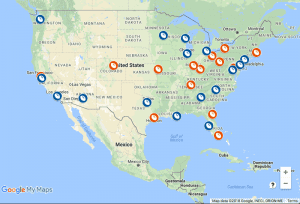At the 2011 United Nations Climate Change Conference, the Durban Platform (and the ad hoc working group on the Durban Platform for Enhanced Action) was established with the aim of negotiating a legal instrument for climate action from 2020 onwards. The resulting agreement is expected to be adopted in 2015. [62] The pact promises to assess progress in 2018 through further reviews every five years. Yes, there is a broad consensus in the scientific community, although some deny that climate change is a problem, including politicians in the United States. When negotiating teams come together for international climate negotiations, there is “less skepticism about science and more disagreement about how to set priorities,” says David Victor, a professor of international relations at the University of California, San Diego. The basic research is this: most experts say no. Countries` commitments are not ambitious enough and are not being implemented quickly enough to limit the rise in global temperature to 1.5°C or even 2°C. The White House is doing everything in its power to remove any mention of global warming from government documents. But the Pentagon could eventually retaliate. Among other things, countries must report on their greenhouse gas inventories and progress towards their targets so that external experts can assess their success. Countries should also reconsider their commitments by 2020 and set new targets every five years, with the aim of further reducing emissions. They must participate in a “global stocktaking” to measure collective efforts to achieve the long-term goals of the Paris Agreement.
In the meantime, developed countries must also estimate the amount of financial assistance they will provide to developing countries to help them reduce their emissions and adapt to the effects of climate change. The Paris Agreement reaffirms the commitments made by developed countries under the UNFCCC; The COP decision accompanying the agreement extends the target of $100 billion per year until 2025 and calls for a new target that starts from “a low of” $100 billion per year. The agreement also broadens the donor base beyond developed countries by encouraging other countries to provide “voluntary” support. China, for example, pledged $3 billion in 2015 to help other developing countries. The NDC Partnership was launched at COP22 in Marrakech to strengthen cooperation so that countries have access to the technical knowledge and financial support they need to achieve large-scale climate and sustainability goals. The NDC Partnership is led by a Steering Committee composed of developed and developing countries and international institutions and led by a support unit based at the World Resources Institute based in Washington, DC and Bonn, Germany. The NDC Partnership is jointly led by the governments of Costa Rica and the Netherlands and includes 93 member countries, 21 institutional partners and ten associate members. The negotiations on the Paris Settlement at COP 24 proved more difficult in some respects than those that led to the Paris Agreement, as the parties faced a mix of technical and political challenges and, in some respects, had greater stakes in trying to develop the general provisions of the agreement through detailed guidelines. Delegates adopted rules and procedures on risk mitigation, transparency, adaptation, financing, regular inventories and other Paris regulations. However, they could not agree on the rules of Article 6, which provides for voluntary cooperation between the parties in the implementation of their NDCs, including through market-based approaches. This strategy included energy and climate policy, including the so-called 20/20/20 targets, namely to reduce carbon dioxide (CO2) emissions by 20%, increase the market share of renewable energy to 20% and increase energy efficiency by 20%. [12] INDCs become NDCs – Nationally Determined Contributions – once a country formally accedes to the agreement.
There are no specific requirements on how countries should reduce their emissions or to what extent, but there have been political expectations regarding the nature and severity of the targets set by different countries. As a result, national plans vary considerably in scope and ambition, largely reflecting each country`s capacities, level of development and contribution to emissions over time. China, for example, has pledged to reduce its carbon emissions by 2030 at the latest and to reduce carbon emissions per unit of gross domestic product (GDP) by 60 to 65 percent by 2030 compared to 2005 levels. India has set a target of reducing emissions intensity by 33-35% from 2005 levels and producing 40% of its electricity from non-fossil fuels by 2030. Every five years, countries should assess their progress in implementing the agreement through a process known as the global stocktaking; The first is scheduled for 2023. Countries set their own targets, and there are no enforcement mechanisms in place to ensure they achieve those targets. Recognizing that many developing countries and small island states that have contributed the least to climate change could suffer the most from its consequences, the Paris Agreement includes a plan for developed countries – and others that are “able to do so” – to continue to provide funds to help developing countries mitigate and increase their resilience to climate change. The agreement builds on financial commitments from the 2009 Copenhagen Accord, which aimed to increase public and private climate finance for developing countries to $100 billion a year by 2020. (To put this in perspective, global military spending in 2017 alone amounted to about $1.7 trillion, more than a third of which came from the United States.) The Copenhagen Compact also created the Green Climate Fund to help mobilize transformative financing with targeted public funds. The Paris Agreement set hope that the world would set a higher annual target by 2025 to build on the $100 billion target for 2020 and put in place mechanisms to achieve that scale. However, China and India, along with the United States, are among the world`s largest annual emitters.
Developed countries have argued that these countries must now do more to combat climate change. Today, the Marrakech Partnership for Global Climate Action expands and continues the Lima-Paris Action Programme and the NAZCA portal has been renamed the Global Climate Action Portal. .


